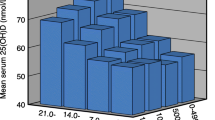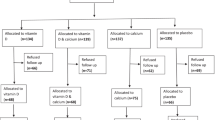Abstract
Background
Calcium and vitamin D are essential nutrients for bone metabolism Vitamin D can either be obtained from dietary sources or cutaneous synthesis. The study was conducted in subtropic weather; therefore, some might believe that the levels of solar radiation would be sufficient in this area.
Aim of the study
To evaluate calcium and vitamin D supplementation in postmenopausal women with osteoporosis living in a sunny country.
Methods
A 3-month controlled clinical trial with 64 postmenopausal women with osteoporosis, mean age 62 ± 8 years. They were randomly assigned to either the supplement group, who received 1,200 mg of calcium carbonate and 400 IU (10 μg) of vitamin D3, or the control group. Dietary intake assessment was performed, bone mineral density and body composition were measured, and biochemical markers of bone metabolism were analyzed.
Results
Considering all participants at baseline, serum vitamin D was under 75 nmol/l in 91.4% of the participants. The concentration of serum 25(OH)D increased significantly (p = 0.023) after 3 months of supplementation from 46.67 ± 13.97 to 59.47 ± 17.50 nmol/l. However, the dose given was limited in effect, and 86.2% of the supplement group did not reach optimal levels of 25(OH)D. Parathyroid hormone was elevated in 22.4% of the study group. After the intervention period, mean parathyroid hormone tended to decrease in the supplement group (p = 0.063).
Conclusion
The dose given (400 IU/day) was not enough to achieve 25(OH)D concentration, considered optimal for bone health.

Similar content being viewed by others
References
Adami S, Viapiana O, Gatti D, Idolazzi L, Rossini M (2008) Relationship between serum parathyroid hormone, vitamin D sufficiency, age, and calcium intake. Bone 42:267–270
Aguado P, Campo MT, Garcés MV, Gonzáez-Casaús ML, Bernad M, Gijón-Banos J et al (2000) Low vitamin D levels in outpatient postmenopausal women from a rheumatology clinic in Madrid, Spain: their relationship with bone mineral density. Osteoporos Int 11:739–744
Barger-Lux MJ, Heaney RP, Dowell S, Chen TC, Holick MF (1998) Vitamin D and its major metabolites: serum levels after graded oral dosing in healthy men. Osteoporos Int 8:222–230
Barnes MS, Robson PJ, Bonham MP, Strain JJ, Wallace JMW (2006) Effect of vitamin D supplementation on vitamin D status and bone turnover markers in young adults. Eur J Clin Nutr 60:727–733
Bischoff-Ferrari HA, Willett WC, Wong JB, Stuck AE, Staehelin HB, Orav EJ, Kiel TADP, Henschkowski J (2009) Prevention of nonvertebral fractures with oral vitamin D and dose dependency a meta-analysis of randomized controlled trials. Arch Intern Med 169(6):551–561
Bjorkman M, Sorva A, Tilvis R (2009) Responses of parathyroid hormone to vitamin D supplementation: a systematic review of clinical trials. Arch Gerontol Geriatr 48(2):160–166
Bolland MJ, Barber PA, Doughty RN, Mason B, Horne A, Ames R, Gamble GD, Grey A, Reid IR (2008) Vascular events in healthy older women receiving calcium supplementation: randomized controlled trial. BMJ 336:262–266
Calvo MS, Whiting SJ, Barton CN (2005) Vitamin D intake: a global perspective of current status. J Nutr 135:310–315
Cashman KD (2007) Diet, nutrition, and bone health. J Nutr 137:2507S–2512S
Cashman KD (2002) Calcium intake, calcium bioavailability and bone health. Br J Nutr 87(2):S169–S177
Chapuy MC, Pamphile R, Paris E et al (2002) Combined calcium and vitamin D3 supplementation in elderly women: confirmation of reversal of secondary hyperparathyroidism and hip fracture risk: The Decalyos II Study. Osteoporos Int 13:257–264
Cummings SR, Melton LJ (2002) Epidemiology and outcomes of osteoporotic fractures. Lancet 359:1761–1767
Dawson-Hughes B, Heaney RP, Holick MF, Lips P, Meunier PJ, Vieth R (2005) Estimates of optimal vitamin status. Osteoporos Int 16:713–716
Ferrari SI (2005) Osteoporosis: a complex disorder of aging with multiple genetic and environmental determinants. World Rev Nutr Diet 95:35–51
Feskanich D, Willet WC, Colditz GA (2003) Calcium, vitamin D, milk consumption, and hip fractures: a prospective study among postmenopausal women. Am J Clin Nutr 77:504–511
Gannagé-Yared MH, Chemali R, Yaacoub N, Halaby G (2000) Hypovitaminosis D in a sunny country: relation to lifestyle and bone markers. J Bone Miner Res 15(9):1856–1862
Grados F, Brazier M, Kamel S, Duver S, Heurtebize N, Maamer M, Mathieu M, Fardellone P (2003) Effects on bone mineral density of calcium and vitamin D supplementation in elderly women with vitamin D deficiency. Jt Bone Spine 70(3):203–208
Holick MF (1999) Vitamin D. In: Shills M et al (eds) Modern nutrition in health and disease, 9th edn. Williams and Wilkins, Baltimore
Holick MF (2007) Vitamin D deficiency. N Engl J Med 357:266–281
Johnell O, Kanis J (2005) Epidemiology of osteoporotic fractures. Osteoporos Int 16(2):S3–S7
Jones G, Horst R, Carter G, Makin HLJ (2007) Contemporary diagnosis and treatment of vitamin D-related disorders. J Bone Miner Res 22(2):v11–v15
Levis S, Gomez A, Jimenez C, Veras L, Ma F, Lai S et al (2005) Vitamin D deficiency and seasonal variation in an adult south Florida population. J Clin Endocrinol Metab 90(3):1557–1562
Levy-Costa RB, Sichieri R, Pontes NS, Monteiro CA (2005) Disponibilidade domiciliar de alimentos no Brasil: distribuição e evolução (1974–2003). Rev Saúde Pública 39(4):530–540
Lips P (2001) Vitamin D deficiency and secondary hyperparathyroidism in the elderly: consequences for bone loss and fractures and therapeutic implications. Endocr Rev 22(4):477–501
Lucas JA, Bolland MJ, Grey AB, Ames RW, Mason BH, Horne AM, Gamble GD, Reid IR (2005) Determinants of vitamin D status in older women living in a subtropical climate. Osteoporos Int 16(12):1641–1648
Meddeb N, Sahli H, Chahed M, Abdelmoula J, Feki M, Salah H, Frini S et al (2005) Vitamin D deficiency in Tunisia. Osteoporos Int 16(2):180–183
Mezquita-Raya P, Munoz-Torres M, Luna J, Luna V, Lopez-Rodriguez F, Torres-Vela E et al (2001) Relation between vitamin D insufficiency, bone density and bone metabolism in healthy postmenopausal women. J Bone Miner Res 16:1408–1414
Moore CE, Murphy MM, Holick MF (2005) Vitamin D intakes by children and adults in the United States Differ among ethnic groups. J Nutr 135:2478–2485
Neuprez A, Bruyère O, Collette J, Reginster J (2007) Vitamin D inadequacy in Belgian postmenopausal osteoporotic women. PMC Public Health 7(147):64–73
Nieves JW (2005) Osteoporosis: the role of micronutrients. Am J Clin Nutr 81:1232S–1239S
NIH (2000) Consensus development program: consensus statements. Osteoporosis prevention, diagnosis, and therapy. 17(1), 27–29 March. Website: http://odp.od.nih.gov/consensus/cons/111/111intro.htm
Ovesen L, Andersen R, Jakobsen J (2003) Geographical differences in vitamin D status, with particular reference to European countries. Proc Nutr Soc 62:813–821
Pinheiro MM, Schuch NJ, Genaro PS, Ciconelli RM, Ferraz MB, Martini LA (2009) Nutrient intakes related to osteoporotic fractures in men and women—The Brazilian Osteoporosis Study (BRAZOS). Nutr J 8:6. doi:10.1186/1475-2891-8-6
Rapuri PB, Gallagher JC, Haynatzki G (2004) Effect of Vitamins D2 and D3 supplement use on serum 25OHD concentration in elderly women in summer and winter. Calcif Tissue Int 74:150–156
Riggs BL, O’Fallon WM, Muhs J, O’Connor MK, Kumar R, Melton LJ (1998) Long-term effects of calcium supplementation on serum parathyroid hormone level, bone turnover, and bone loss in elderly women. J Bone Miner Res 13(2):168–174
Sabbagh Z, Vatanparast H (2009) Is calcium supplementation a risk factor for cardiovascular diseases in older women? Nutr Rev 67(2):105–108
Saraiva GL, Cendoroglo MS, Ramos LR, Araújo LMQ, Vieira JGH, Kunni I et al (2005) Influence of ultraviolet radiation on the production of 25 hydroxyvitamin D in the elderly population in the city of São Paulo (23°34′S), Brazil. Osteoporos Int 16:1649–1654
Steingrimsdottir L, Gunnarsson O, Indridason OS, Franzson L, Sigurdsson G (2005) Relationship between serum parathyroid hormone levels, vitamin D sufficiency, and calcium intake. JAMA 194:2336–2341
Talwar SA, Aloia JF, Pollack S, Yeh JK (2007) Dose response to vitamin D supplementation among postmenopausal African American women. Am J Clin Nutr 86:1657–1662
Trivedi DP, Doll R, Khaw KT (2003) Effect of four monthly oral vitamin D3 (cholecalciferol) supplementation on fractures and mortality in men and women living in the community: randomised double blind controlled trial. BMJ 326:469–474
Van der Mei IAF, Ponsonby AL, Engelsen O, Pasco JA, McGrath JJ, Eyles DW et al (2007) The high prevalence of vitamin D insufficiency across Australian populations is only partly explained by season and latitude. Environ Health Perspect 115(8):1132–1139
Vieth R (1999) Vitamin D supplementation, 25-hydroxyvitamin D concentrations, and safety. Am J Clin Nutr 69:842–856
Vieth R, Bischoff-Ferrari H, Boucher BJ, Dawson-Hughes B, Garland CF, Heaney RP, Holick MF, Hollis BW, Lamberg-Allardt C, McGrath JJ, Norman AW, Scragg R, Whiting SJ, Willett WC, Zittermann A (2007) The urgent need to recommend an intake of vitamin D that is effective. Am J Clin Nutr 85:649–650
Webb AR (2006) Who, what, where and when—influences on cutaneous vitamin D synthesis. Prog Biophys Mol Biol 92:17–25
World Health Organization (WHO) (1994) Study group assessment of fracture risk and its application to screening for postmenopausal osteoporosis. WHO Technical Report Series 843, Geneva, Switzerland
Acknowledgment
Financial Support: CNPq no. 401883/2005-1 and CAPES.
Author information
Authors and Affiliations
Corresponding author
Rights and permissions
About this article
Cite this article
Pignotti, G.A.P., Genaro, P.S., Pinheiro, M.M. et al. Is a lower dose of vitamin D supplementation enough to increase 25(OH)D status in a sunny country?. Eur J Nutr 49, 277–283 (2010). https://doi.org/10.1007/s00394-009-0084-0
Received:
Accepted:
Published:
Issue Date:
DOI: https://doi.org/10.1007/s00394-009-0084-0




